Go-To-Market Strategies: EVERYTHING YOU MUST KNOW TODAY!

A go-to-market (GTM) strategy is a strategy that assists you in defining your ideal customers, coordinating your messaging, and positioning your product for launch.
Without good preparation, it's impossible to tell if you're chasing the wrong audience, entering a market too early or late, or targeting a sector that's oversaturated with similar solutions - and you don't want to risk spending time and money on an unprofitable product launch.
A GTM approach also puts critical business units on the same page, allowing you to satisfy a market need while iterating on your product successfully.
To avoid potentially devastating snags and snags, you must develop a deliberate, practical, and effective go-to-market strategy. But, more often than not, that process is difficult to traverse.
The last thing you want to do when launching a new product is introduced it without a comprehensive go-to-market (GTM) plan framework, but before we go into how to create a go-to-market plan, let's define it.
What is a Go-To-Market Strategy?
A go-to-market (GTM) strategy is a detailed plan developed to successfully introduce a product to market. In general, a solid GTM strategy identifies a target demographic, includes a marketing plan, and outlines a sales strategy. While each product and market are unique, a GTM strategy should identify a market need and position the product as a solution to that problem.
A GTM strategy is simply how a corporation takes a product to market. It's a useful roadmap that assesses a solution's viability and anticipates its performance based on market research, historical precedents, and competitive data.
It's also important to note that go-to-market tactics aren't limited to tangible things. A GTM strategy might be created for a new service, a new branch of your firm, or even a whole new business.
Who needs it?
Anyone who finds himself in one of the three scenarios listed below requires a GTM strategy:
-
Introducing a new product into an existing market
-
Introducing a current product into a new market
-
Putting a new product's market for expansion to the test
This is important for both individuals and businesses in the B2B space like us!
Why do you need it?
Even if you put in a lot of work, time, money, and resources to produce a new product or service, a poorly thought-out go-to-market strategy might cause your project to fail.
Some of the most well-known businesses have even failed to enter new markets. Take, for example, Apple. In the 1980s, decades before the game-changing iPhone, Steve Jobs directed one of Apple's biggest flops: the Apple Lisa computer.
Despite having some of the best graphics technology available at the time, Lisa barely sold 10,000 units. Critics blame Lisa's misleading advertisements and expensive prices, despite its limited computing power.
While Apple and Steve Jobs recovered, smaller businesses may have a lot more to lose if they launch a product with a poor plan. As you create something new, it's critical to build a go-to-market strategy that is tailored to your budget and buyer profile.
Developing a go-to-market strategy will help you avoid many of the blunders and oversights that often derail new product launches. Even if the product is well-designed and unique, poor product-market fit and oversaturation can derail a launch.
While a go-to-market strategy cannot ensure success, it can assist you in managing expectations and ironing out any hitches before investing in bringing a product to market. We have a free go-to-market strategy template that can help you design a strategy that presents your product in front of your target audience to help you with this process.
What are the different types of go-to-market strategies?
The two main strategies we have found are - Product-led & Sales-led.
A product-led GTM strategy acquires and retains consumers through the product itself.
In this strategy, the product acts as a salesperson by delivering so much value that the user is compelled to upgrade their package. Calendly and Slack are excellent instances of product-led growth at work.
A sales-led GTM strategy, on the other hand, employs marketing to generate interest in a product, which is then captured in content and demo formats.
Salespeople will then contact those prospects in the hopes of converting them into customers. It is noted that most B2B SaaS startups take this approach.
Go-To-Market Plan Methodologies

Delving in a little deeper from the previous topic, we’ve seen two major methods for developing a GTM strategy - Funnels and Flywheels.
While the typical, one-time funnel strategy focuses on capturing prospects and nurturing them into sales, the flywheel approach focuses on building long-term client relationships through inbound marketing and other strategies.
While the funnel focuses on the customer's awareness, deliberation, and decision stages, the circular flywheel focuses on attracting, engaging, and delighting prospects, leads, and customers.
When a lead converts to a customer, the flywheel continues as the organisation is entrusted with attracting, engaging, and satisfying them through good customer experiences, fresh content, and maybe new services.
Whether you've chosen the flywheel or prefer the funnel, these phases should be included in your planning approach.
-
Create your buyer persona(s). (Pro-tip: we have an article about customer profiles here)
-
Fill out the value matrix for your persona.
-
Determine your content and lead-generation plan.
-
As you proceed, make adjustments and iterations.
-
Retain & satisfy your clients.
Key components of a GTM Strategy
We thought we'd go over four major components of a GTM plan before sharing our go-to-market strategy structure.
All of these issues are covered in the step-by-step guide we'll provide below, so you don't need to answer these questions right now. Still, they're worth remembering, especially if you're designing a never-before-seen product.
Here are the key components of a go-to-market strategy:
-
Product-Market Fit: What issue(s) does your product address?
-
The intended audience is: Who is affected by the issue that your product addresses? What is their willingness to pay for a solution? What are the frustrations and pain areas that you can alleviate?
-
Competition and Demand: Who else is selling what you're selling? Is there a market for the goods, or is it oversaturated?
-
Distribution: How are you going to market the goods or services? A website, an app, or an independent distributor?
Now, you might be thinking - That’s all nice and well, but when are you going to tell us how to build this strategy?
To which, our answer is - well, right now.
Steps to build your GTM strategy
1. Identify The Personas
As corny as it may sound, the first step in preparing your product for market is to consider your consumer.
Gartner estimates that the average buying group for a complicated B2B solution includes six to ten decision-makers. This group of people is known as the "purchasing centre."
Each of those buyers normally fulfils one of the following tasks (though some job titles may occupy more than one role):
-
Initiator: Someone who initiates the purchasing process or expresses first interest.
-
User: Someone who consistently uses your product.
-
Influencer: Someone who persuades others that a product is required.
-
Decision maker: The person who gives final approval for the transaction.
-
Buyer: Controls the budget.
-
Approver: The final approver who drives the proposal forward on a broader scale (typically someone in the C-suite)
-
Gatekeeper: A person who prevents a product from being implemented or approved.
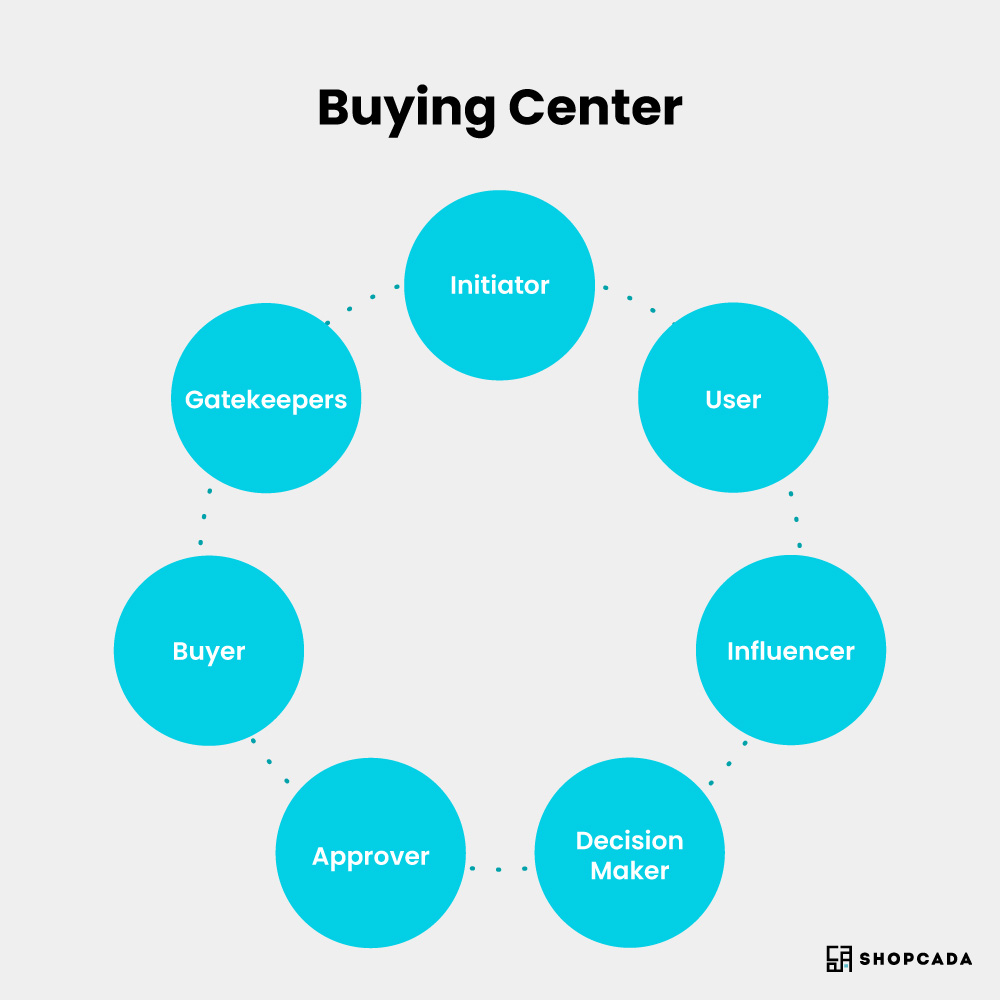
These roles differ according to the product, industry, and sector to which you are marketing. Gather your team and brainstorm the many job titles that may be affected by your solution.
Investigate each role to gain a general understanding of what they do, their aims, and their pain areas. It's vital to understand who these people are, what motivates them, and what their challenges are because they'll be the ones putting your product on the map.
Your personas and client profiles provide a detailed description of your ideal customer.
The type of consumer that may get significant benefits from your product or service while simultaneously providing you with enough value in return to make your firm profitable.
Most of the time, this will be the ability to use your product to increase their bottom line, but there may be other advantages, such as:
-
Cost-cutting measures
-
Increasing efficiency
-
Improving employee productivity and well-being
In exchange, your profiles and personas provide you with value in the form of revenue. They may also provide referrals, customer feedback, and testimonials.
To create your client profile, you must first understand some fundamental concepts such as:
-
Who are they?
-
Where do they work?
-
What kinds of obstacles do they face daily?
Of course, there are more things to take into account and consideration when making your customer profiles and personas. For a more detailed article on this topic, as mentioned earlier, feel free to read through our customer profile article.
2. Researching Your Competitors
Understanding your product's or service's place in the existing landscape is critical to any GTM approach.
This is because understanding what your competitors have to offer and recognising the value they add helps you position your offering.
Begin by looking over their G2 reviews page and filtering by relevant business segments. SME, mid-market, or enterprise, for example.
This will enable you to determine what they enjoy and dislike most about competitors' platforms, as well as what resonates with your intended customer profiles/personas. It's also worth thinking about how global and micro developments can affect your launch now and in the future.
3. Craft A Value Matrix To Help Identify Messaging
After you've created your personas and researched your competition, it's time to create your value matrix.
A value matrix is a summary of each persona, their business concerns, and how your solution solves those problems.
An appropriate marketing message relating the problem and solution together will also be included in the value matrix.
Make a chart with one column for each persona. List the daily challenges that each persona faces below. Include them in a row below if your product can fix or alleviate any of these issues.
Finally, the messaging must effectively convey the pain point and value. Agitating the pain point is the best approach to accomplish this. People will take a pain reliever to treat a headache but are much less likely to take a daily vitamin to prevent the pain from occurring in the first place. The value your product provides should alleviate discomfort rather than act as a vitamin.
An example of a value matrix:

4. Testing Your Messaging
After you've established your value matrix, it's time to put your message to the test. Begin promoting on marketing platforms with the messages you've just prepared for different audience members.
You'll have three factors to test: the channel on which you advertise, the audience you want to reach, and the message you want to communicate.
Consider where your audience is before determining where to test. LinkedIn, Google Ads, Facebook, and Twitter are all potential paid digital ad channels. Test the various channels and keep advertising on those with the highest conversion rates. Also, cease investing in channels with low conversion rates.
5. Optimising Your Messages
Following that, maximise your audience. Advertisers can use highly focused audience settings on some ad networks. LinkedIn, for example, provides options for job title, job function, firm size, and geographic region. Different choices should be tested to identify who is more likely to click or convert.
For example, we noticed a spike in clicks in particular businesses, so we began targeting and allocating our ad spend to those areas on LinkedIn. The trick here is to spend your money where you will see the most return on investment.
And you'll be testing your messaging to find which variations are the most effective with your target demographic. Your ad's engagement and conversion rates will reveal which value propositions and pain points work best. Once you've gathered this information, you may use it to inform broader initiatives.
6. Understand The Buyer’s Journey
After you've created your personas and value matrix, go further to understand the route a potential customer will take, both from the buyer's and your company's perspectives.
The purchasing process is linear from the standpoint of your customer. It will go something like this:
The customer recognises they have a business problem and researches the subject.
The buyer narrows down viable solutions.
That list is cut down by speaking with solution provider sales teams and evaluating product use cases until a decision is made.
From the standpoint of the business, the buyer's journey used to be a funnel. There is a lot of general interest at the top of the typical sales funnel. It increasingly narrows when opportunities exit the pipeline.
This trip was divided into three parts:

However, the sales funnel is no longer the most effective approach to view your buyer's journey. Instead, I recommend the flywheel model, which offers a more holistic approach that puts your customer first and converts prospects to customers to active promoters.
Customers go through three stages in the flywheel model: Attract, Engage, and Delight.

The attract phase comes first. At this point, content catches the eye of a potential customer. This could take the shape of a blog post, whitepaper, or video. A lead arrives here after clicking on an advertisement, social media post, or search engine result. These activities, however, do not imply that this lead is yet ready to make a purchase.
Following that is the engage phase. A prospect has proved that they have an issue that your solution can answer at this point. They demonstrate this by digital action such as downloading an ebook or participating in a webinar, which allows you to engage them with educational content.
While each company's lead generation and qualification processes vary, marketing is normally in charge of the entice and engage phases. Through messaging and content, your marketing team will need to develop interest and awareness, as well as educate the relevant audience on the value of a product (more on that later).
The prospect should request a quote or a trial period halfway through the engagement phase. They're about to decide on whether or not to buy.
The sales staff takes over when the prospect reaches this step. Typically, the procedure will look like this:
-
Contact: The lead and sales rep begin communicating.
-
Qualification: The sales representative learns more about the firm, and their customers' pain issues, and asks questions to determine whether they meet the basic requirements for purchasing the product (BANT - Budget, Authority, Need, Timing is a popular sales qualification method, but several other sales methodologies are used to qualify).
-
Business case: The prospect uses a free trial to assess if the product meets their needs.
-
Evaluation: Organisational decision-makers balance the expense of the product against the results obtained throughout the business case.
-
Negotiation: Sales representatives and decision-makers negotiate pricing details and feature requirements.
-
Close: A transaction is reached, and your prospect becomes a customer.
-
(Optional) Renewal: Your consumer renews their contract or subscription.
The lead exits the engage phase and enters the delight phase immediately after your sales professional closes the sale. When your consumer reaches this point, they should be pleasantly surprised by an easy onboarding procedure and polite customer service alternatives.
Following that, your consumer should ideally become a promoter. They bring you additional consumers, which keeps the flywheel spinning and allows you to develop faster.
7. Choose A Sales Strategy
You've completed all of the necessary groundwork; now it's time to choose a strategy for launching your product into the market. Because no single strategy will work for every product or industry, you must examine your complexity, scalability, and cost of yours.
There are four general go-to-market sales strategies, each of which caters to a distinct product and business strategy.
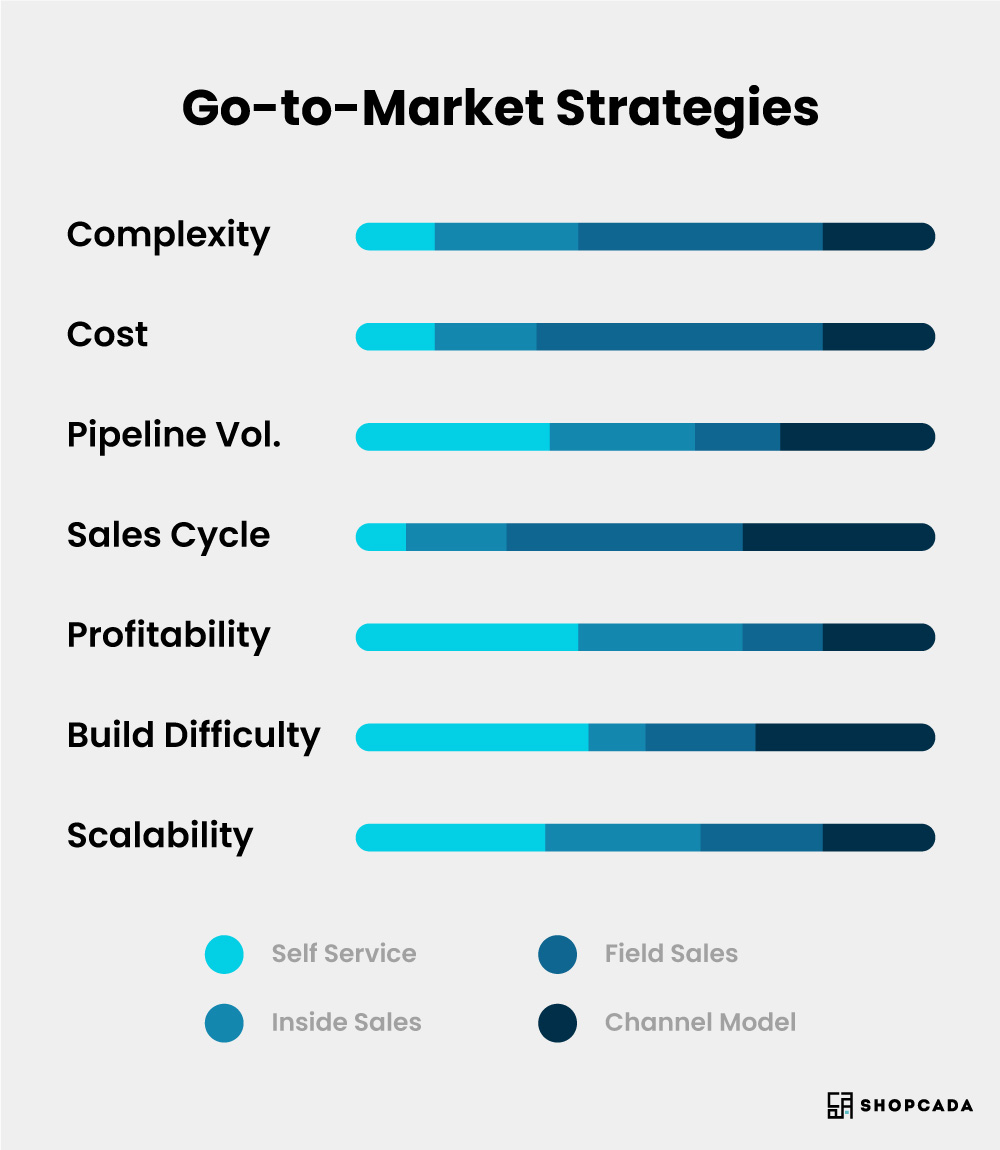
Self-Service
When a customer purchases on their own, they are using the self-service paradigm. This paradigm is most commonly seen in B2C purchasing, where a customer can search and buy a product through a website, such as Netflix or Amazon.
This is most effective for basic products with a low-cost point and a high volume of sales. It is tough to construct, but once completed, it has a short sales cycle, no expense to recruit salesmen, and is highly profitable.
While you will not require a sales team, you will require a marketing team to generate traffic and conversions to your website. The core marketing team would most likely comprise professionals in growth marketing, performance marketing, and content marketing, as well as other team members.
Inside Sales Business Model
When a prospect needs to be nurtured by a sales rep to convert into a deal, the inside sales business model is used. This paradigm works best with products of medium complexity and cost.
The sales cycle might last anything from a few weeks to several months. You'll put money into the sales staff here, although inside sales reps are less expensive than field reps.
This model can be lucrative with a big number of sales and is quite simple to create and scale as you add more team members. In this arrangement, the sales team is often made up of a sales manager who supervises a small number of reps.
Field Sales Business Model
When you have a full sales team that closes huge corporate deals, you have a field sales business model. These are often sophisticated products with high price points, implying a low volume of deals with a protracted sales cycle.
Because the field reps are skilled, high-salary personnel, the sales force under this approach is frequently highly expensive. This technique is simple to implement but difficult to scale because hiring and training a full sales staff takes time and money.
A sales manager, field salespeople, sales engineers, a sales development representative (SDR) team, and sales operations are all members.
The Channel Model
Finally, an outside agency or partner sells your goods for you in the channel model. This is challenging to construct since people can be difficult to attract and educate on the benefits of your product. They are also frequently less driven to sell than your own sales crew.
However, because you do not need to employ your own sales crew, this is a low-cost approach. It works well with a product that is of interest to the partner. For example, if you offer phone cases, you may want to look for partners who sell related products, such as Best Buy or Apple.
You can combine these tactics based on your industry or consumer size (i.e., number of licences or seats). Businesses should scale gradually rather than engage in a costly sales team too early.
8. Build Awareness Via Inbound/Outbound Methods
You must now fill your pipeline by capturing your target audience's attention. This is accomplished through demand generation, which can be accomplished through both inbound and outbound techniques.
Prospects discover your brand through marketing efforts and reach out to you or exhibit indicators of interest organically using inbound. Social media, content, or paid ads leading to a landing page are all examples of organic inbound traffic pathways.
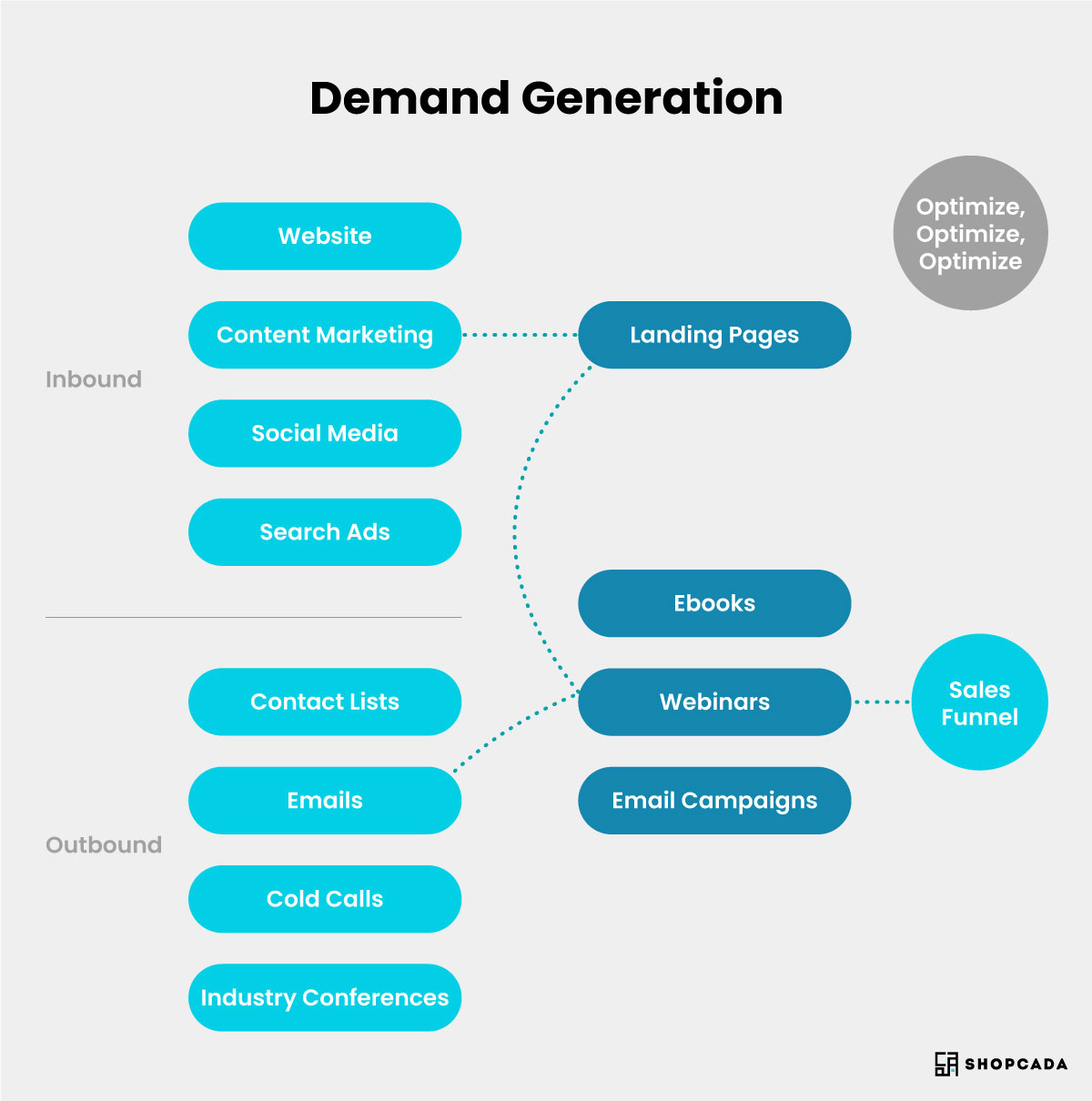
When a salesman approaches a lead via cold outreach strategies, this is referred to as outbound demand creation. They may accomplish this via contacting a contact list, sending warm emails, calling leads, or gathering leads at industry conferences.
After generating interest through these tactics, sales discussions begin, and leads are directed to more instructional content and subsequently into the sales funnel.
9. Build Awareness Via Inbound/Outbound Methods
In general, inbound leads are easier to convert and less expensive to acquire than outbound leads. This is because inbound prospects are already partially educated on the business problem you solve, are aware of your solution, and are usually more interested in purchasing your goods.
Content marketing is essential for generating inbound interest because it drives traffic to your website.
Your content marketing team will generate this inbound traffic by identifying and targeting keywords that your potential consumers would look for, as well as developing and posting relevant content on your website.
Search engine optimisation (SEO) is the process by which a search engine ranks the content on the internet once a query is entered into the search bar. This will be a significant source of organic site traffic for you.

What exactly is content marketing? It's a never-ending cycle of keyword research, creation, and evaluation.
Keyword research: Identifying keywords relevant to your product, analysing the volume (how frequently that keyword is searched), the difficulty of ranking for that keyword (i.e., how competitive that keyword is), and determining who is already ranking for those keywords.
Content research: Brainstorming content topics that contain that term. Look for existing articles on these topics and start planning your content calendar.
Content creation: Put your thoughts into action by hiring a writer to publish articles about them.
Design: Make your material more visual and engaging by including relevant photos, infographics, videos, and other multimedia.
Promote: Distribute your material and increase traffic to your website by posting links on social media or through emails to your client database.
Build links: Reach out to other publishers and urge them to link to your work to increase traffic. This increases your site authority, which enhances your SEO rankings.
Conversion rate: Track and measure your content's engagement and conversion rates. Continue to perform what works and discontinue what does not. Then, restart the content development cycle.
Your content team should provide content that corresponds to the different stages of the buyer's journey (top-of-funnel, middle-of-funnel, bottom-of-funnel).
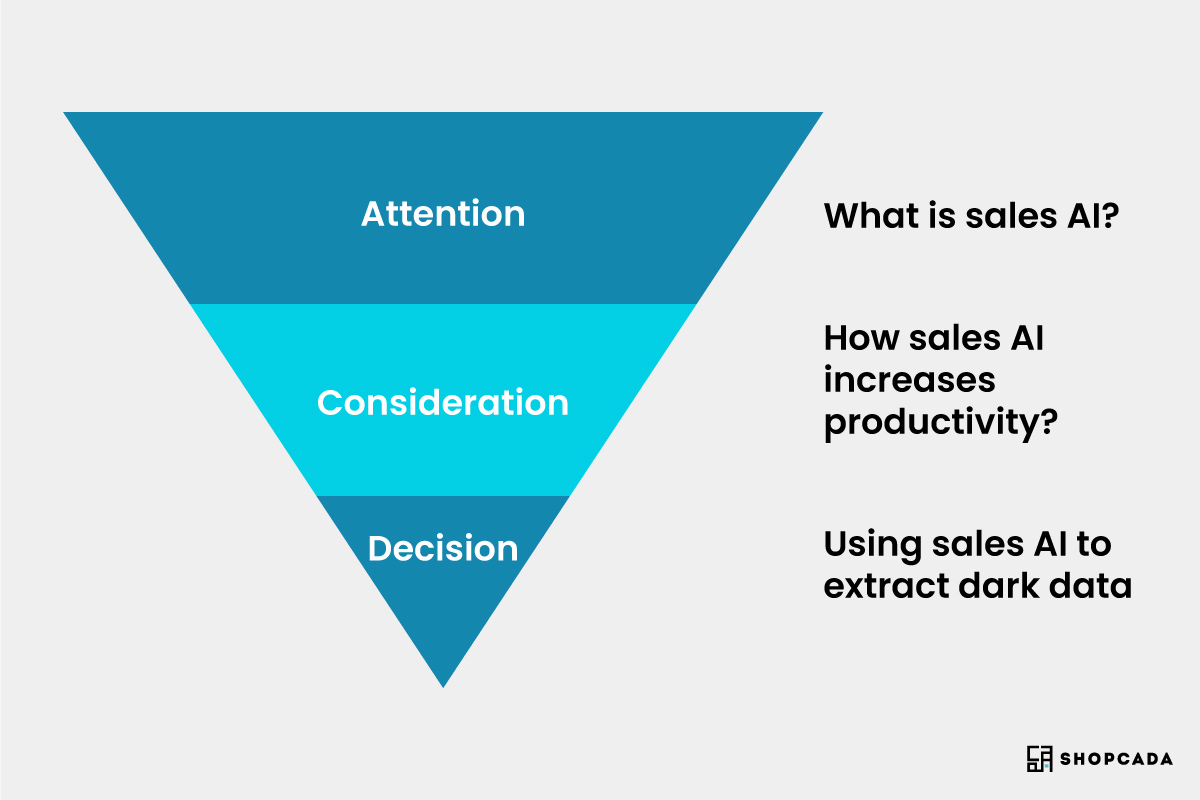
The top of the funnel has lighter educational information, the middle of the funnel contains deeper, more practical learning, and the bottom of the funnel contains knowledge for individuals who are ready to buy and implement.
10. Optimising Your Pipeline And Increase Conversion Rates
Growth takes more than just deciding on a sales strategy and developing a demand creation process. You need to optimise.
Sales is a numbers game, and only by measuring progress can you be successful. Volume, conversion rate, and time are the key performance indicators (KPIs) for managing a sales staff.
You should also keep track of how many opportunities enter the flywheel: your pipeline volume.
Then, keep note of how many leads became clients. The overall conversion rate can be calculated by comparing the volume of pipeline possibilities to the number of won deals.
Optimising the conversion rate between phases is even more critical. As opportunities go through the funnel, they will go through several qualifying stages (e.g., basic qualifications, current solutions in use, technical evaluation, and close), and you will want to track when and why they fall out.
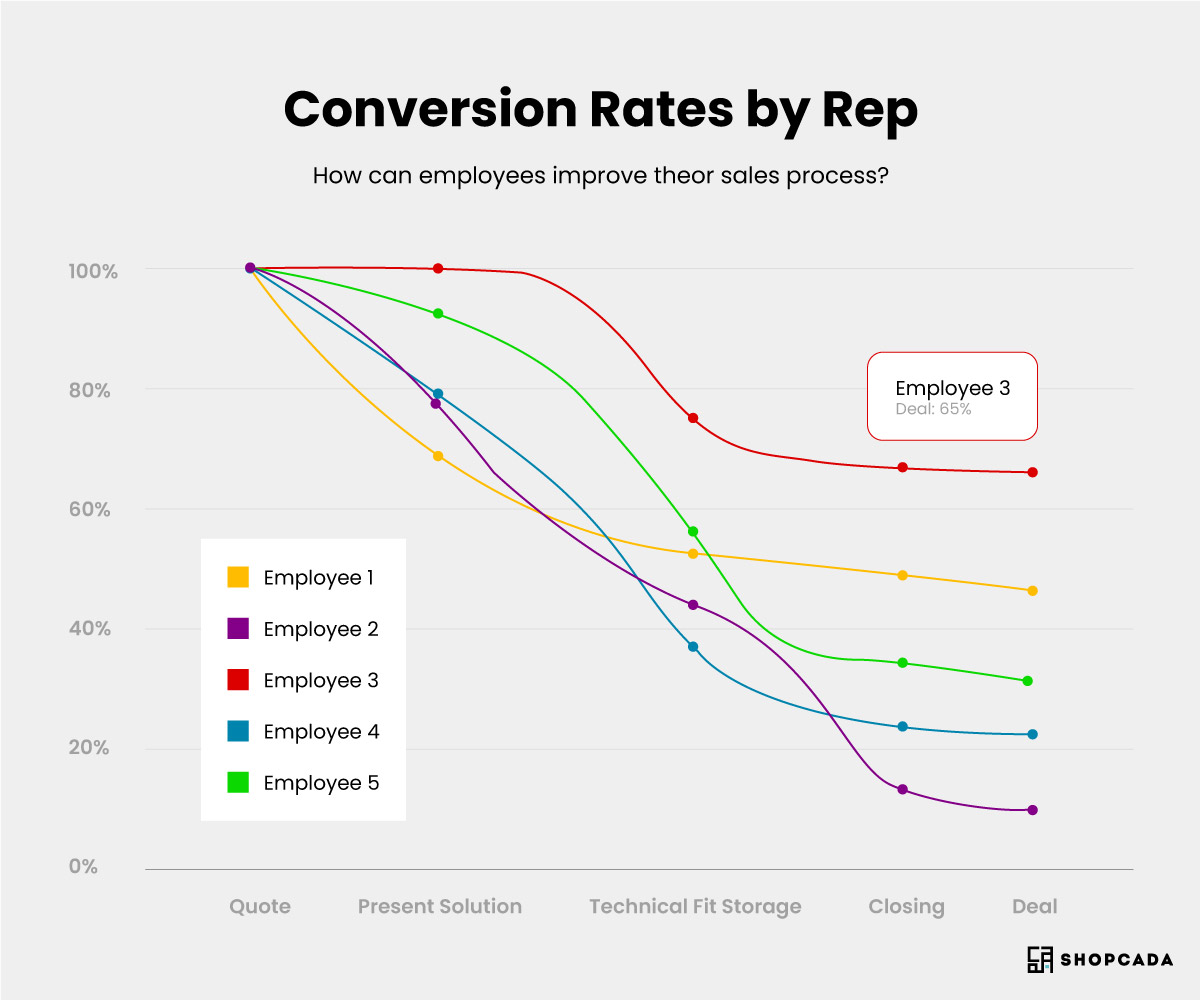
This must be measured both for the whole flywheel and for each sales rep. This data indicates where each rep needs to improve and possibly receive additional instruction. Work to tailor your sales coaching efforts to shorten each rep's sales cycle. Compare time and conversion rate to determine who is better and faster at each level.
Track how many opportunities each rep converts and where they drop out in the process. The sooner an unqualified chance exits the flywheel, the less time, energy, and resources are expended on that particular lead.
11. Analyse & Shorten Sales Cycles
Finally, keep track of the length of your sales cycle. This is the time it takes for a lead to enter the sales funnel and become a closed/won contract. The goal is to reduce the time it takes to convert between each stage. This can be accomplished by identifying typical objections (and iterating methods to eliminate them before they occur), conducting continual lead nurturing, and brainstorming strategies to locate the best-fit consumers.
12. Reduce Customer Acquisition Costs
You will also need to optimise your customer acquisition cost as a business owner. This will be highly expensive at the start, but you will need to minimise this cost over time by improving your operations, or you will lose more money than you make.
The cost of acquiring a new customer or deal per $1 is referred to as customer acquisition. The smaller the cost of customer acquisition, the less impact your marketing efforts have on your PNL, and the better your profit per customer.
13. Tap Into Existing Customer Base
A popular industrial cliche is that acquiring a new customer costs seven times more than doing business with an existing customer. Because previous consumers already know, like, and trust you if you provide a wonderful shopping experience.
Renewals, cross-selling, and upselling are the finest ways for businesses to make more and gain revenue. A company's average cost to renew a product is $0.13, whereas upsells cost $0.28.
Many individuals consider sales to be a black box. However, with the proliferation of analytics and new sales AI technology, corporate executives can improve their processes to accelerate growth.
14. Adjust On The Fly
Building a successful business is not limited to those entrepreneurs who have been endowed with particular abilities.
You've probably already built your product, and starting a business is a similar process. You must be strategic throughout the process and continue to improve.
Take your time and keep iterating, and you, too, can grow a firm. Return to the parts of your plan that aren't working and make changes. Take note of what is working and come up with strategies to expand on it.
15. Retain & Satisfy Your Customers
During this phase, you will concentrate on preserving customer relationships and spreading positive word of mouth.
Closing Words
Remember, before you can put together a plan or strategy, you must conduct some research and dig. Your go-to-market plan covers a lot of ground in a short, condensed amount of time. And, before you dive in and start filling out page after page, be sure you understand what you're doing.
Running a business does not have to be difficult (and in fact, we think the best companies prioritise balance, not non-stop hustle). However, launching a new product into the market can feel like a do-or-die situation. However, this does not have to be the case.
If you invest the effort in developing a sound go-to-market plan based on the framework we just described, you should be able to build your company in a more measured and meaningful manner. It may appear to be more effort now, but by planning your approach and performing the work ahead of time, you will be playing chess while the competition is playing checkers.

